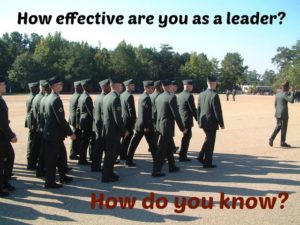Leadership effectiveness means using our leadership behaviours to create the results we want efficiently. It’s relatively simple to measure our results, but how can we really know if our leadership communications and activities are adding value or if  our teams and followers are succeeding despite our efforts?
our teams and followers are succeeding despite our efforts?
We Cannot Know
It is reasonable to start with the assumption that we cannot possibly know the impact of our leadership if we use only our own perspective. I wrote the article “I Don’t Know What I’m Doing” about this phenomenon.
Of course, in the simplest leadership situations, such as leading a troop of marchers, we can turn around and assess our results easily and immediately. And we can experiment (shout louder, shout faster etc.) and have instant feedback on the impact of those choices. But most organizational leadership is not that simple.
The operating function of the human brain makes it inevitable that we are mostly unaware of what we are doing. That’s a good thing, because otherwise digesting lunch would take a lot more effort. But it means that we cannot accurately assess ourselves as leaders. My own observations show that I am particularly unaware of my leadership effectiveness when I am ineffective. When I’m under pressure, or when I’m emotionally triggered, my brain tends to greatly limit my awareness. For example in a conflict when I am upset, my mind will loudly remind me why I am right, and completely ignore any other points of view that might exist. With this blinkered awareness, it is unlikely that I will make the best possible decision for the highest common purposes. I will be protecting myself, and denying it as well.
In addition to our own limited awareness, there’s the problem that our followers don’t tend to give us accurate information on our leadership effectiveness. First of all, many of them do not have the skills and experience to communicate accurately about our leadership effectiveness. It’s not easy to express the subtle aspects of communications and influencing skills. They have their own self-protective blind spots. And most frequently, business relationships are not deep enough to withstand the risks of honest feedback. Sub-ordinates prefer to keep nice, easy relations with their leaders, even though they may suffer from the leadership missteps.
Many organizational cultures undervalue upward feedback in the hierarchy. Formal mid-year and annual reviews keep feedback flowing from leader to team member, but the upward feedback questions often don’t even get asked, as if they are somehow less important or less valid.
We Can Know
By embracing the need for feedback, and using the most effective tools and methods for gathering it, we can know how effective we are as leaders, and we can use that knowledge to improve our results.
Simply asking our followers for feedback is a good start, but the more advanced you are as a leader, the less likely it is that this method will show you how to improve. Because relatively bad leaders are quite common, team members are frequently just very grateful for moderately good leaders and they have not put much thought into how they could improve.
The Leadership Circle Profile solves this problem by integrating advanced research and technology to provide a very clear picture of leadership which works for a very wide range of leaders while providing a great deal of subtly in the results. The information is presented in a user-friendly format that allows for meaningful interpretation. The model deepens the meaning of the feedback by shining a light not only on leadership competencies –what the leader does, but also on reactive tendencies –the unconscious patterns of thinking that are behind our most intractable ineffectiveness.
We Can Improve
Improving our leadership requires even more feedback to guide us through the change process. We need to measure leadership results in terms of the perceptions, feelings and impacts on our followers, and that can only be measured with their close involvement. The trick is to keep it very simple and to measure only a small number of criteria at a time.
The deepening relationships that result from this kind of leadership development work are good for the soul. We can build our respect for other human beings: those who we rely on to tell us how we are doing, and those who courageously aim for self-improvement in order to achieve the most difficult and important results that only excellent (and constantly developing) leaders can create.
If you are ready to learn what makes your leadership effective and ineffective, please drop me a line to set up a phone call with me, and we’ll talk about what tools would best serve you.
